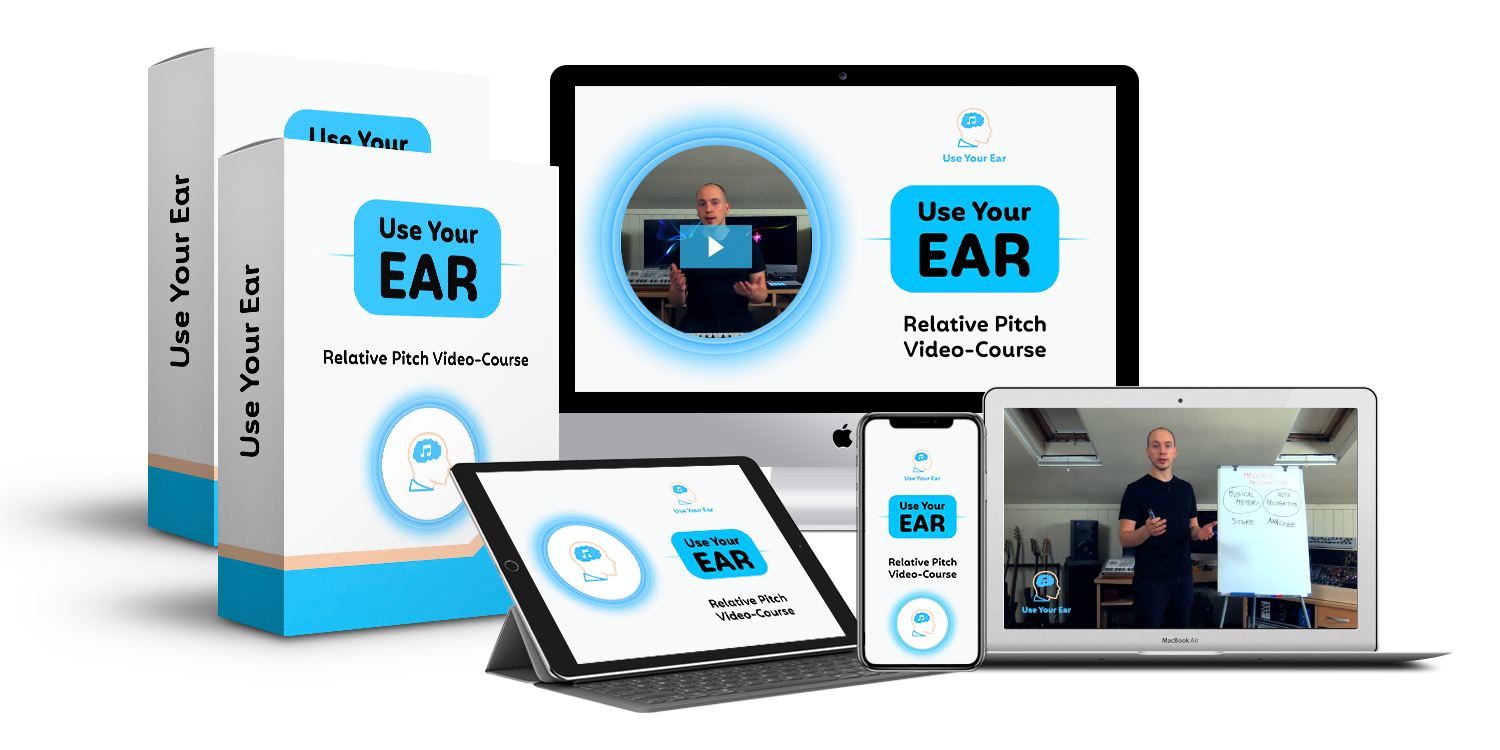Music Interval Identification Ear Training
How many of these questions have you asked yourself while listening to music?
- What are those chords?
- What scale is that?
- What note is that?
- Why does that one note sound so good there?
- Why can’t I recognize the intervals in this melody?
We feel your pain! It can seem impossible to dissect a piece of music by ear using traditional aural interval training.
There’s got to be a good reason why so many of us struggle with something so fundamental.
Maybe we should take a look at a few potential issues, and try to figure out a solution!

Intervals definition
If you’re familiar with ear training then you have definitely heard of intervals.
They are simply the distance between two notes. For most people, recognizing intervals is the only ear training method they have ever come across, unfortunately… it never seems to work very well.
For a more in-depth look at interval definitions and terminology read this.
Types of interval
You may already be familiar with the qualities of intervals (major, minor, diminished, etc), but types of musical intervals are often overlooked.
-
Diatonic or chromatic: When a group of notes belong within a key (such as C Major), we call this diatonic, whereas chromatic intervals span the entire range of notes.
-
Simple or compound: A simple interval is any two notes played within one octave. A compound interval is when the distance between two notes is larger than one octave - when played in chords these intervals are often referred to as ‘extensions’.


-
Harmonic or melodic: Harmonic intervals are two notes played at the same time - in harmony. Melodic intervals are in sequence. When you sing the melody to your favorite song, the steps in between each note are melodic intervals.
-
Consonant or dissonant: Consonant intervals feel more stable as opposed to dissonant intervals which often have a sense of tension that needs to be resolved. Try playing a C and an F# together then move the F# up a semitone to G.
Can you feel which note is more unstable and which feels more ‘at home’?
This tension and resolution can be felt even by non-musicians because it’s a natural way of experiencing music. We’re talking about a vital part of how humans intuitively relate to sound - unfortunately, it’s entirely ignored by traditional intervals ear training methods.
Ear training with interval recognition - is it really that important?
If you’re reading this then you’ve probably done some type of interval-based ear training, and it hasn’t worked for you. Or maybe you’re totally new to the world of ear training and feel a little lost?
Don’t worry - you’ve come to the right place.
You’ll hear tons of people say, “If you want to improve your ear training practice intervals”.
We’re sorry, but those people have put you on the wrong path. Of course, we should be good at interval identification, but if you can only do that when practicing your ear training exercises, what’s the point?
Indeed, the main issue is that those abilities never truly transfer over to real music, and there’s plenty of scientific research explaining why.
One of the big issues is: hearing things (intervals included) in isolation vs hearing things in context.

Does interval ear training help you play by ear?
Unfortunately, interval ear training will never help develop your musical intuition, which is essential for playing by ear and improvisation. The isolated nature of interval-based ear training doesn’t prepare you for real-world situations.
You may have used various ear training sites or apps to practice some kind of ‘intervals hearing test’, but even if you get really good scores, it’s not going to improve your musicality in the slightest.
Traditional music interval training actually hinders your ability to intuitively recognize the notes and the chords, like great musicians do. This is because the interval ear training approach is centered around a very cumbersome thought process. Moreover, the interval method neglects the fact that our perception of musical pitch is context-dependent.
This means: the same interval (let’s say an “ascending major third”) can sound extremely different depending on the harmonic context it’s in.
A little confusing? Keep reading and all will become clear…
Interval ear training exercises - does it make sense?
How can you expect to recognize intervals or chords in a real musical situation if you only ever practice one interval at a time in total isolation with no musical context (meaning - no accompaniment, no chords in the background, no musical key being established, etc.)? It’s not possible.
Typical interval identification exercises are totally impractical, there are at least 5 big issues with the interval method, but let’s examine just one:
Do you use some sort of reference melody to help you remember certain intervals - like a famous melody perhaps?
This might work for one interval in isolation, but what if you’re trying to figure out a melody with five or more notes (like most real melodies are)? Are you seriously going to recognize all those intervals by humming a different reference melody, for each one, in real-time? Good luck with that.
If this flaw isn’t already obvious enough, let’s make a quick comparison.
When you look at a color, do you think to yourself:
“hmm… well that color looks like a mixture of the sky and a tomato, and I’ve memorized that the sky is blue and a tomato is red so… red + blue = purple, AHA! I’m seeing purple!”
Of course not. When you see purple you just instantly recognize it, there’s no need for a series of clunky thoughts and calculations to get there. So why do we do this with music?
We need to start understanding sounds the same way we understand visuals - intuitively and instantly.

Let’s explore the “sky & tomato” analogy a little further to really uncover the big problem with intervals ear training.
As we know the sky doesn’t always look blue - when it’s cloudy we see gray, at night it appears black. The same goes for tomatoes - when unripe they’re green, some varieties are yellow, etc.
And yet we still recognize what they are, regardless of color. Why is that the case?
It’s because these things are independent from their colors, in other words - the color may change, but what it is remains the same.
This is the big issue that most musicians aren’t aware of:
Just like how the sky and tomatoes look different depending on the situation, so too can the sound of intervals depending on the musical context!
Although it’s still the same interval (theoretically speaking), it assumes a lot of extremely different sounds depending on the tonality/scale/chords being played.
Long story short…You don’t recognize intervals in real music because they sound extremely different from how you hear them in isolation (during your intervals ear training practice).
Interval ear training tips
What’s our best intervals ear training tip? Stop focusing on intervals!
“What are you tryin’ to tell me? That I can dodge intervals?”
“No Neo, I’m trying to tell you that when you’re ready - you won’t have to.”
Understanding the importance of the tonal context will give you a more immediate connection to the feeling or ‘color’ of each note. Once this is internalized - recognizing, melodies, intervals, chords, etc. comes much easier!
Free your mind!

Want to learn ear training methods that really work? We can help!
So you’ve now seen a few reasons why interval ear training methods are lacking and want to know how to get on the right path?
Until recently, comprehensive relative-pitch courses were basically non-existent, and so musicians like yourself were stuck with outdated programs that left them frustrated.
This is one of the main reasons we developed the Use Your Ear method.
After years of rigorous research and extensive testing, we’re proud to share our system proven to get incredible results.

Relative Pitch Video-Course
If you’re ready to gain some real improvements from your ear training routine, why not treat yourself, and your ears, to a whole new musical perspective!
We’ve got a great video course that shows our unique science-based method, which will take you step-by-step to exactly where you need to be.
By following our video-course you’ll be able to instinctively recognize melodies, chord progressions, etc. with your ears alone. Learn to sing through your instrument - instead of searching for the right notes through trial and error. And with a more intuitive understanding of harmony you’ll gain a much deeper connection to music - thousands of other students have already seen these benefits and more - who wouldn't want that?
The Use Your Ear video course is available nowFree Use Your Ear Workshop
If it all sounds too good to be true, why not check out our free workshop?
There’s loads of useful information and freebies included over the course of 3 hours, with no strings attached!
We’ll show you our step-by-step, science-based method, offer some valuable tips and techniques that will be tailored to your current level, and get you started on the road to developing a fantastic musical ear.
Free online ear training workshop

Individual online lessons
If you prefer the instant feedback of a tutor, or want to really sharpen your skills in a specific area - some 1-on-1 lessons with our expert ear training instructors could be just what you need.
One-on-one ear training lessons onlineWho are our courses for?

If your goal is to develop great ear training skills and grow your inner sense of pitch and musicality, our courses are definitely for you.

No matter your skill level, or knowledge of music theory, we’re ready to help you improve. We’ve already helped thousands of other musicians like you, that went through years of frustration before finding the Use Your Ear method.

If you’ve been struggling to get good results from ear training, you may have just found the solution to your problems!





